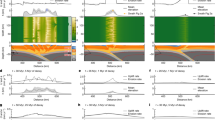Abstract
Landscape evolution is the window to the link between deep earth and surface processes. One of the key issues in landscape evolution is to characterize the topographic steady state of mountain belts. The Taiwan mountain belt is an extraordinary case due to its extremely high uplift and denudation rates. The uplift of Taiwan Island is caused by the oblique collision between the Luzon Arc and the East Asian continent. In this case, the mountain building process in the north always occurs earlier than that in the south, which causes the spatial distribution of steady-state regions. The East Central Range receives much research attention with the presence of river basins that mainly distribute along the trajectory of the collision propagation. Normally, based on analyses of geomorphic parameters, the whole Central Range, or at least part of it, should be at a topographic steady state. However, the balance between uplift rates and denudation rates that exist in these regions is seldomly tested. In this contribution, we make a comprehensive literature review on the uplift and denudation rates derived from various approaches, including sediment yields, in-situ cosmogenic nuclide 10Be, incision of river channels, thermochronology, and GPS observations. This literature review reveals that the topographic steady state may prevail in the northern and middle parts of the East Central Range. However, an obvious inconsistency in denudation rates calculated by different methods prevents us from better constraining the topographic steady state in some regions of this mountain range.


The data are sourced from Chen et al. (2006)
Similar content being viewed by others
References
Byrne T, Chan YC, Rau RJ, Lu CY, Lee YH, Wang YJ (2010) The Arc-Continent Collision in Taiwan. Front Earth Sci 4:213–245
Chen CY, Willett SD (2016) Graphical methods of river profile analysis to unravel drainage area change, uplift and erodibility contrasts in the Central Range of Taiwan. Earth Surf Process Landf 41:2223–2238. doi:10.1002/esp.3986
Chen YC, Sung Q, Chen CN (2006) Stream-power incision model in non-steady-state mountain ranges: An empirical approach. Chin Sci Bull 51:2789. doi:10.1007/s11434-006-2194-x
Cheng KY, Hung JH, Chang HC, Tsai H, Sung QC (2012) Scale independence of basin hypsometry and steady state topography. Geomorphology 171–172:1–11. doi:10.1016/j.geomorph.2012.04.022
Ching KE, Hsieh ML, Johnson KM, Chen KH, Rau RJ, Yang M (2011) Modern vertical deformation rates and mountain building in Taiwan from precise leveling and continuous GPS observations, 2000–2008. J Geophys Res Solid Earth. doi:10.1029/2011jb008242
Clift PD, Schouten H, Draut AE (2003) A general model of arc-continent collision and subduction polarity reversal from Taiwan and the Irish Caledonides. Geol Soc Lond Spec Publ 219:81–98
Clift PD et al (2008) Post-collisional collapse in the wake of migrating arc-continent collision in the Ilan Basin, Taiwan. Spec Pap Geol Soc Am 436:257–278
Dadson SJ et al (2003) Links between erosion, runoff variability and seismicity in the Taiwan orogen. Nature 426:648–651. doi:10.1038/nature02150
Derrieux F et al (2014) How fast is the denudation of the Taiwan mountain belt? Perspectives from in-situ cosmogenic 10Be. J Asian Earth Sci 88:230–245
Hovius N, Lin JC (2000) Supply and removal of sediment in a landslide-dominated mountain belt: central range, Taiwan. J Geol 108:73–89
Hsieh ML, Liew PM, Hsu MY (2004) Holocene tectonic uplift on the Hua-tung coast, eastern Taiwan. Quat Int 115–116:47–70. doi:10.1016/S1040-6182(03)00096-X
Huang CY, Yuan PB, Tsao SJ (2006) Temporal and spatial records of active arc-continent collision in Taiwan: a synthesis. Geol Soc Am Bull 118:274–288
Kao SJ, Milliman JD (2008) Water and sediment discharge from small mountainous rivers, Taiwan: the roles of lithology, episodic events, and human activities. J Geol 116:431–448
Kao SJ, Lee TY, Milliman JD (2005) Calculating highly fluctuated suspended sediment fluxes from mountainous rivers in Taiwan. Terr Atmos Ocean Sci 16:653–675
Kao SJ, Jan S, Hsu SC, Lee TY, Dai M, Lee TY (2008) Sediment budget in the Taiwan Strait with high fluvial sediment inputs from mountainous rivers: new observations and synthesis. Terr Atmos Ocean Sci 19:525–546
Lee YH, Chen CC, Liu TK, Ho HC, Lu HY, Wei L (2006) Mountain building mechanisms in the southern central range of the Taiwan Orogenic Belt—from accretionary wedge deformation to arc–continental collision. Earth Planet Sci Lett 252:413–422
Siame LL et al (2011) Erosion rates in an active orogen (NE-Taiwan): a confrontation of cosmogenic measurements with river suspended loads. Quat Geochronol 6:246–260
Song SR, Liu CM, Chen CH, Lo W (2004) Pumice layers in marine terraces: implications for tectonic uplift rates on the east and northeast coasts of Taiwan over the last hundreds of years. Quat Int 115–116:83–92. doi:10.1016/S1040-6182(03)00098-3
Stolar DB, Willett SD, Montgomery DR (2007) Characterization of topographic steady state in Taiwan. Earth Planet Sci Lett 261:421–431
Whipple KX (2001) Fluvial landscape response time: how plausible is steady-state denudation? Am J Sci 301:313–325
Whipple KX (2004) Bedrock rivers and the geomorphology of active orogens. Annu Rev Earth Planet Sci 32:151–185. doi:10.1146/annurev.earth.32.101802.120356
Acknowledgements
This work was supported by National Natural Science Foundation of China (Grant Nos. 41376049 and 41225020), National Programme on Global Change and Air-Sea Interaction (GASI-GEOGE-03), and by AoShan Talents Program Supported by Qingdao National Laboratory for Marine Science and Technology (No. 2015ASTP-OS11).
Author information
Authors and Affiliations
Corresponding author
Additional information
11th International Symposium on Geochemistry of the Earth’s Surface.
Rights and permissions
About this article
Cite this article
Deng, K., Yang, S. Test the topographic steady state in an active mountain belt. Acta Geochim 36, 511–514 (2017). https://doi.org/10.1007/s11631-017-0222-y
Received:
Revised:
Accepted:
Published:
Issue Date:
DOI: https://doi.org/10.1007/s11631-017-0222-y




